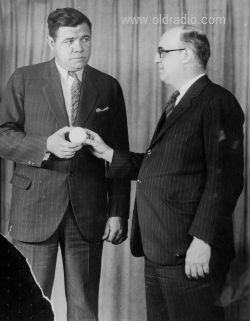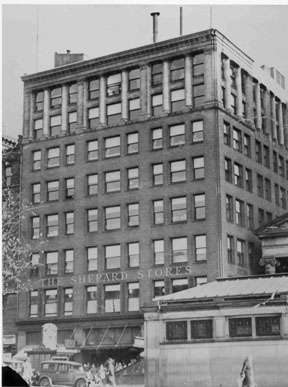
by Donna Halper, Emerson College
(revised April 2001)
A rare photo of two legends-- Babe Ruth
and John Shepard 3rd!
(photo courtesy of the Boston Public Library, used with permission)
John Shepard 3rd (born 19 March 1886/ died 11 June 1950) was a controversial figure in Boston radio from the 1920s through the 1940s-- some people found him ruthless and abrasive, but he was also an innovator. Here are only a few of his achievements:
WNAC (owned by the Shepard Department Stores) signs on at 250m./ 1199 kHz (July 31, 1922; Shepard (alias "JS"-- announcers only used initials back then) and various of his store employees worked on air. The station is on the 5th floor of the downtown Boston store on Winter Place.
In early November of 1922, WNAC broadcasts what may be the first live Broadway musical, as the performers of the successful black show "Shuffle Along" (including Eubie Blake and Noble Sissle) do hit songs from the show; the broadcast is in conjunction with the Boston Radio Exposition at Mechanics Hall, and is very well received. Shepard has had black performers on the air since the earliest days of his station, including several classically trained vocalists.
WNAC and WEAF (New York) link up on January 4, 1923 for the first chain broadcast (it lasts for only five minutes, but shows that it CAN be done).
On 11 October 1923, at the first convention of the National Association of Broadcasters, in New York, John Shepard is elected their Vice President.
On 10 December 1923, Shepard is among a small delegation of influential broadcasters who meet with President Calvin Coolidge to discuss the future of radio broadcasting.
WNAC is first to offer live broadcasts of synagogue services, beginning 20 January 1924; Rabbi Harry Levi, "the Radio Rabbi" becomes the first Boston rabbi to use broadcasting as a way of teaching tolerance and educating the public about what Jews believe. He becomes so popular that two books of his radio sermons are issued.
WNAB, sister station of WNAC goes on the air at 1200 kHz/ 250 m (May 13, 1925). Shepard also introduces 'house names'-- his secretary, Bertha Mitchell, was known as 'Jean Sargent'; she had begun broadcasting bedtime stories in 1923 and later ran the Women's Show. When she left in mid-1925, she was replaced by another woman, who was also given the on-air name of Jean Sargent.
WNAC does what may be the first live broadcast of a Boston Red Sox home game, (versus the New York Yankees) on April 13, 1926.
WNAB (Shepard Stores) changes its call letters to WASN-- Air Shopping News (Jan. 31, 1927); it is prototype for what we know today as home shopping. Unique for its time, it features an all-female staff-- Station Manager is Marion Smith, and one of the announcers, Grace Lawrence, will become a regular with the Yankee Network later on. Another staff member, Claire Crawford, will become one of the few women radio sales managers in the 30s.

| The main Shepard Store in downtown Boston; a rare 1928 photo of the original home of WNAC: John Shepard 3rd moved WNAC to the Hotel Buckminster in 1929-30 due to establishing the Yankee Network and needing more room... but from 1922 through much of 1929, people could come to the well-known department store, do some shopping and then watch a radio broadcast. (photo courtesy of the Boston Public Library, used with permission) |
WBIS-- "Boston's Information Service"-- (yet another station owned by the Shepard Department Stores) is on the air at 302.8m/ 990 kHz; its hours are very limited, and it also broadcasts shopping news, as well as some phonograph records (obtained from the record department of the Shepard Store). WBIS replaces WASN. (June, 1927)
WAGS, a low-power station (only 5 watts) in Somerville goes on the air at 1200 kHz; its owners will ultimately move it to Lexington where it will become WLEX (October 1927) -- the owner of WAGS, and later co-owner of Boston's first TV station, W1XAY, is Jesse Smith Dodge. “Jack” Dodge began as an announcer on WGI, and then went to WNAC as a engineer, a position he held simultaneously with working for WNAC... clearly, Shepard knew about and was supportive of Dodge's venture.
John Shepard, who had shared some WNAC programming with his Providence station WEAN since the early 20s, expands that link into the Yankee Network, adding WNBH, New Bedford, as his first affiliate station. There will soon be affiliates all over New England. (May 25, 1930)
WLEX joins Shepard's Yankee Network on Jan. 20, 1931; by April 20, Shepard owns the station, which becomes WAAB, operating out of the same Boston studios as WNAC. Meanwhile, Shepard promotes Claire Crawford to Assistant Sales Manager of the Yankee Network, the first woman in New England to hold a management position of this level.
In March 1934, frustrated by a lack of co-operation between the local newspapers and his station, Shepard, aided by Leland Bickford, starts his own news service for his affiliates. It is called the Yankee News Network, and in a slap at newspapers, the slogan the network uses is "News while it is news." Shepard's efforts on behalf of his radio reporters result in broadcast journalists getting the same access and press credentials that only newspaper reporters had gotten previously.
In 1937 (August 18th), Shepard is granted a construction permit to put the first FM station in Massachusetts on the air. It is licensed to Paxton (near Worcester). Shepard had met and become impressed with Armstrong, and threw his support 100% behind FM, even to the point of starting an organization of FM Broadcasters. W1XOJ goes on the air on May 27, 1939, with 2000 watts. To get the programming from the Boston studios of the Yankee Network out to Paxton, a low power relay station (W1XOK, with 250 watts) is also put on the air. On April 29, 1941, W1XOJ becomes known as W43B. Also in late December of 1937, to devote more time to his broadcasting ventures, Shepard had closed the Boston Shepard Store; the Providence store remained open.
In November of 1939, a dispute with a disgruntled former employee (Lawrence Flynn) leads to Flynn forming his own company (Mayflower Broadcasting) and trying to get the FCC to award him WAAB's license. His efforts fail, but the FCC decision in the case, called the "Mayflower Decision" will forbid radio from editorializing or taking stands on issues; that ruling won't be reversed until the late 40s.
On September 30, 1942, WAAB is officially moved from Boston to Worcester. (Shepard had tried for years-- unsuccessfully-- to get a station in western Massachusetts; he had even tried to move WLEX out there, but to no avail...) WAAB's building will eventually be home to the FM station, WGTR (see next item). In March, with great fanfare, the Shepard stations plus the Yankee Network had moved to state-of-the-art new studios on Brookline Avenue, near their former location, the Hotel Buckminster.
In November of 1943, W43B becomes WGTR (General Tire Company), after the General Tire Company purchases a controlling interest in the Yankee Network. Shepard remains with the corporation in an executive capacity till 1949.
John Shepard died in mid June of 1950. His brother Robert continued to run the Providence Shepard store till 1970 when he sold it; the store was closed in 1974. The Shepard family maintained a charitable trust for many years; among its gifts was a 1972 donation of $7000 to WERS-FM at Emerson College. Shepard's wife Mabel died at the family home in Brookline in 1992; she was 102. TheYankee Network, which Shepard founded, did its last broadcast on February 26, 1967.
--- Donna Halper is a famous lecturer and broadcast consultant
based in Quincy, MA. Her love of radio history is evident in the way she
captures the essence of her subjects.